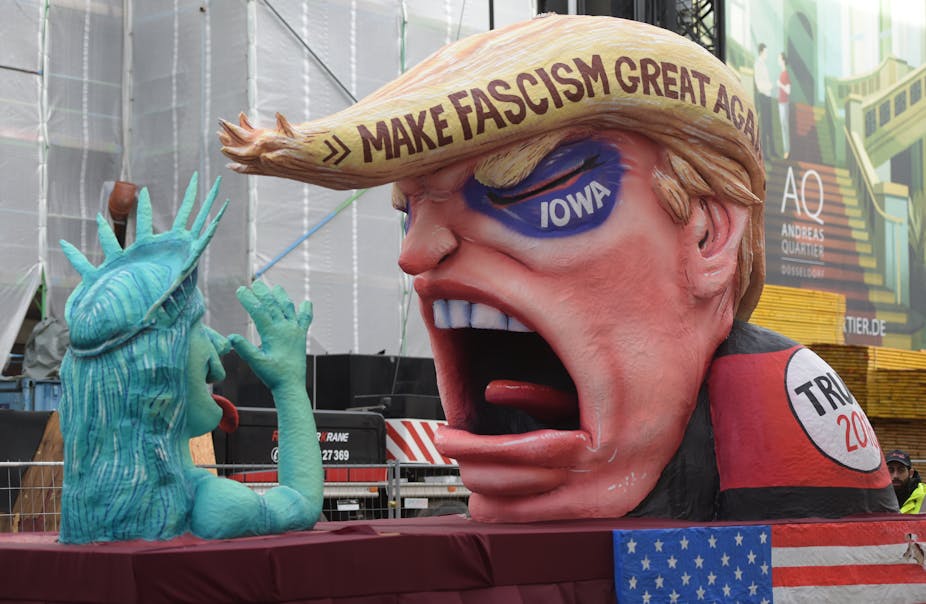The word “fascism” has recently reemerged as a key piece of political terminology. The headlines immediately after Donald Trump’s election as president of the US read like a disturbing question and answer session.
“Is Donald Trump a Fascist?” asked Newsweek. The Washington Post had the answer, declaring “Donald Trump is actually a Fascist”, but later sought to quantify things in a bit more detail with “How Fascist is Donald Trump?”. Meanwhile, Salon agreed that “Donald Trump is an actual Fascist”.
That all raises the question: what actually counts as fascism? It’s a question that has its own history, just as Nazism and fascism themselves do. And it’s similarly not without controversy.
Defining what counted as Nazism and fascism in the immediate aftermath of World War II was an urgent task faced by allied administrators and jurists in Germany and Italy. Examining these projects and their effects may help shed some light on how we talk, or perhaps on how we ought to think before talking, about fascism today.
Nazis on trial
The Allies charged numerous members of the Nazi leadership with a series of war crimes in Nuremberg in 1946. Historical transcripts depict lively debates on the subject of who counted as a Nazi, in a country in which 8.5m people were affiliated with the Nazi party. In Nuremberg, neither the German state nor the German people were held collectively guilty. However, several of the principal Nazi organisations were deemed criminal.
Still, at the trials it was individuals who were publicly punished. A total of 24 top political and military officials were tried and ten were hanged.

The later trial of Adolf Eichmann reopened the question of collective vs individual responsibility. Eichmann had been a high-ranking Nazi official and was condemned to death at trial in 1960. He was hanged in 1962. Over the years, it has been argued at length that his trial was an attempt to individualise the responsibility of the Nazis. Eichmann was isolated as a specific perpetrator while the prosecutors largely set aside the existence of the rest of the Nazis’ criminal machinery. Just as in the immediate post-war period, balancing individual liability and collective responsibility was a complex and uneasy process.
After Mussolini
In Italy, Allied military administrators faced a similar task. When Mussolini was overthrown in July 1943, they had to decide whether Italy continued to constitute an aggressor nation or if it was the victim of Mussolini’s regime. Were Mussolini and fascism identical with Italy and Italians, or were they separate things?
This latter perspective was the view eventually taken. In his defining statement on the subject, entitled “who is fascist”, Italian liberal philosopher Benedetto Croce argued that fascism was a disease to which any particular individual, regardless of their background, might succumb. Punishment, therefore, must follow the same logic: no social category in particular could be guilty – not even fascist party members.
So, unlike in the German case, there were no collective charges brought in Italy. In fact, in 1946, a collective amnesty for fascist crimes was introduced and previously prosecuted fascists were almost all released. Within a decade and a half of the end of the war, a reborn version of Mussolini’s fascist party was helping to prop up a governing coalition (a direct descendent of which just polled at 4.35% in Italian elections).
How we talk about fascism
Today, each new far-right electoral success or white supremacist protest is greeted with shock. We struggle to believe how many people turn up to such events. Perhaps this is because we continue to think of fascism as a political ailment that, almost by definition, afflicts only a small number of particularly pathological cases. Of course, that was not the case in Germany and Italy under Hitler and Mussolini’s regimes, even if processes of denazification and defascistisation largely targeted small groups of individuals.
Of course, those processes took far longer than the time frame of any specific trial, and, many would argue, remain incomplete. In neither case did people go to sleep as fascists and wake up the next day as liberal democrats. But when we talk of fascism today we often talk as if that model of the regimes were accurate: we concern ourselves with identifying individuals – like Trump – who “count” or do not “count” as fascist, as if they are on trial.
But just as fascism was not dismantled by the trials alone, so the same is true of the ways in which these movements developed, and appear to be developing now. They are not the spontaneous results of a sudden transformation in specific people, but steps in an open-ended process. Their roots are diffuse and hard to grasp. Grasping them is perhaps more difficult than pointing at particular individuals as “fascist”, but it is surely at least as important.

